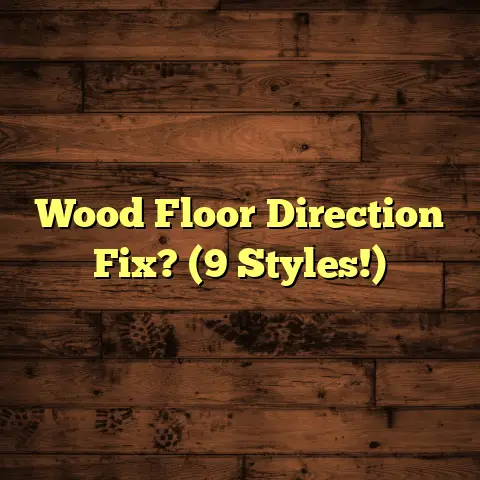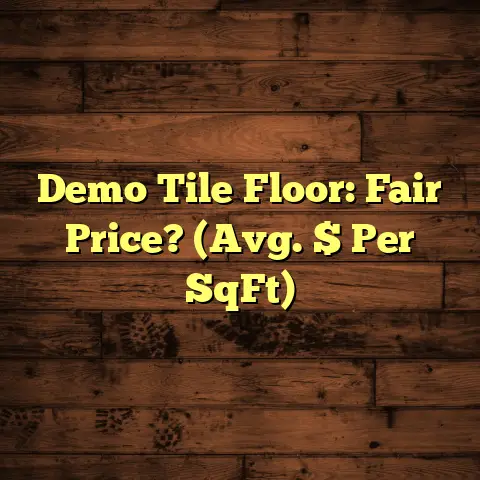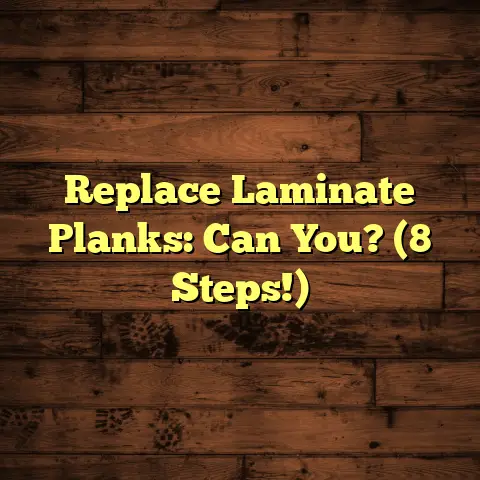Best Roomba For Floors? (Top 5 Damage Risks!)
I’m a flooring contractor, and I’ve seen it all – the good, the bad, and the downright ugly when it comes to floors.
And let me tell you, robotic vacuums like Roombas have become a real hot topic.
They’re convenient, sure, but are they really the best choice for your floors?
Let’s dive in and uncover the truth, including the top 5 damage risks you absolutely need to know about!
The Versatility of Roomba Vacuum Cleaners
Roombas have seriously shaken up the cleaning game.
No more lugging around a heavy vacuum!
These little robots offer a hands-free way to keep your floors tidy.
What makes them so adaptable?
Well, it’s a combo of smart navigation, customizable schedules, and specialized brushes.
Many models can seamlessly transition from hardwood to carpets, making them super convenient for homes with different flooring types.
But hold on – before you rush out and buy one, let’s talk about potential pitfalls.
Section 1: Overview of Roomba Models and Their Flooring Capabilities
Okay, let’s break down the Roomba lineup.
There’s a model for pretty much every budget and need.
You’ve got everything from the entry-level models to the high-end ones with all the bells and whistles.
Each one has its own tech, suction power, brush design, and navigation system.
For instance, some have stronger suction that’s perfect for pulling dirt out of carpets.
Others have softer brushes that are gentler on hardwood.
The navigation systems also vary.
Some use basic sensors to bounce around, while others use advanced mapping to clean more efficiently.
Here’s a quick rundown of some popular models:
- Roomba 600 Series: A budget-friendly option, great for basic cleaning on hard floors and low-pile carpets.
- Roomba i7+: Self-emptying and smart mapping make this a premium choice.
- Roomba s9+: Boasts powerful suction and advanced navigation for thorough cleaning.
- Roomba j7+: Designed to avoid obstacles like pet waste and charging cords.
- Roomba Combo j7+: A 2-in-1 robot vacuum and mop.
Choosing the right Roomba depends on your specific flooring and cleaning needs.
For example, if you have mostly hardwood, you’ll want a model with soft brushes and adjustable suction.
If you have thick carpets, you’ll need something with strong suction and a powerful brush roll.
Section 2: Top 5 Damage Risks When Using Roombas on Floors
Alright, let’s get to the heart of the matter: the potential damage risks.
While Roombas can be a lifesaver, they’re not without their downsides.
I’ve seen firsthand the issues they can cause if you’re not careful.
Here are the top 5 damage risks to keep in mind:
1. Scratching Hard Surfaces
This is a big one.
Roomba brushes and wheels, especially on older or cheaper models, can scratch hardwood, laminate, and even some tile floors.
Think about it: a small piece of grit trapped under a wheel or a stiff brush bristle dragging across the surface.
Over time, this can lead to unsightly scratches and scuff marks.
Specific models to watch out for:
Older models with stiffer brush bristles.
Models with worn-out wheels that have lost their smooth coating.
Tips to mitigate this risk:
- Regularly clean the Roomba’s brushes and wheels: This removes any trapped dirt or debris that could cause scratches.
- Use a Roomba with soft-bristle brushes: These are gentler on hard floors.
- Consider a Roomba with adjustable suction: Lower suction can reduce the risk of scratching.
- Test the Roomba in an inconspicuous area first: See how it performs before letting it loose on your entire floor.
2. Getting Stuck on Rugs and Carpets
Roombas aren’t always the smartest cookies.
They can struggle with certain types of rugs and carpets, especially those with tassels, fringe, or high pile.
The Roomba can get tangled, stuck, or even damage the rug itself.
I’ve seen Roombas try to “eat” rug fringes, leaving them frayed and worn.
Problematic areas to identify:
- Rugs with loose fringes or tassels
- High-pile carpets
- Rugs with uneven surfaces
- Area rugs that aren’t securely anchored
How to avoid this issue:
- Remove or secure loose rugs: Either put them away or use rug pads to keep them in place.
- Tuck in or trim rug fringes: Prevent the Roomba from getting tangled.
- Use virtual walls or no-go zones: Block off areas where the Roomba is likely to get stuck.
- Choose a Roomba with carpet boost: This feature increases suction on carpets but can also increase the risk of getting stuck.
3. Water Damage from Cleaning Modes
Some Roombas, like the Roomba Combo j7+, have mopping capabilities.
While this sounds great in theory, it can be a recipe for disaster if you’re not careful.
Water damage is a serious concern for floors like hardwood, laminate, and even some types of tile.
If water seeps into the seams or cracks, it can cause swelling, warping, and discoloration.
Best practices for using mopping functions safely:
- Only use the mopping function on floors that are designed for moisture exposure: This includes sealed tile, vinyl, and some types of engineered hardwood.
- Use the recommended cleaning solution: Avoid harsh chemicals that could damage your floors.
- Monitor the Roomba closely: Make sure it’s not leaving excessive water on the floor.
- Dry any excess water immediately: Use a clean cloth to wipe up any puddles.
- Avoid using the mopping function on unsealed or damaged floors: These are more susceptible to water damage.
4. Impact Damage
Even with advanced navigation, Roombas can still bump into furniture, walls, and baseboards.
Over time, this can lead to scuff marks, dents, and other types of impact damage.
I’ve seen plenty of baseboards that have been chipped and scratched by a Roomba’s constant bumping.
Preventive measures to minimize these risks:
- Use edge-cleaning mode sparingly: This mode can cause the Roomba to bump into walls more frequently.
- Install bumper guards on furniture: This will protect your furniture from scratches and dents.
- Use virtual walls or no-go zones: Block off areas with delicate furniture or easily damaged surfaces.
- Choose a Roomba with advanced navigation: These models are better at avoiding obstacles.
- Regularly inspect your floors and furniture for damage: Catch any problems early before they get worse.
5. Battery Leakage
This is a rare but serious risk.
If a Roomba’s battery leaks, the corrosive chemicals can damage your floors.
This is especially true if the Roomba is stored improperly or if the battery is old or damaged.
I’ve seen cases where battery acid has stained and even eaten away at flooring materials.
Guidance on safe storage and maintenance:
- Store the Roomba in a cool, dry place: Avoid extreme temperatures and humidity.
- Remove the battery if you’re not going to use the Roomba for an extended period: This will prevent leakage.
- Use only the recommended battery: Using a generic or incompatible battery can increase the risk of leakage.
- Inspect the battery regularly for signs of damage: Look for swelling, corrosion, or leakage.
- Dispose of old batteries properly: Follow local regulations for hazardous waste disposal.
Section 3: Comparing the Top 5 Roomba Models for Flooring Performance
Let’s get down to brass tacks and compare some of the top Roomba models on the market.
I’ll give you the lowdown on their key features, pros and cons, and how they interact with different flooring types.
1. Roomba s9+
- Key Features: Powerful suction, advanced navigation, self-emptying base.
- Pros: Excellent cleaning performance on all floor types, including carpets.
- Cons: Expensive, can be noisy, may scratch delicate floors if not used carefully.
- Flooring Interaction: Best for homes with a mix of carpets and hard floors.
2. Roomba i7+
- Key Features: Smart mapping, self-emptying base, customizable cleaning schedules.
- Pros: Good cleaning performance, convenient self-emptying feature.
- Cons: Can be expensive, may struggle with high-pile carpets.
- Flooring Interaction: Suitable for homes with mostly hard floors and low-pile carpets.
3. Roomba j7+
- Key Features: Obstacle avoidance, smart mapping, self-emptying base.
- Pros: Avoids pet waste and charging cords, good cleaning performance.
- Cons: Expensive, may not be as powerful as the s9+.
- Flooring Interaction: Ideal for homes with pets and a mix of floor types.
4. Roomba 600 Series
- Key Features: Basic cleaning, affordable price.
- Pros: Budget-friendly, easy to use.
- Cons: Limited features, less powerful suction, may scratch delicate floors.
- Flooring Interaction: Best for small apartments with mostly hard floors.
5. Roomba Combo j7+
- Key Features: 2-in-1 vacuum and mop, obstacle avoidance, smart mapping.
- Pros: Versatile, convenient mopping function.
- Cons: Can be expensive, mopping function may not be suitable for all floor types.
- Flooring Interaction: Suitable for homes with sealed hard floors that can tolerate moisture.
Customer Reviews and Expert Opinions:
I’ve scoured customer reviews and expert opinions to give you a balanced perspective on each model.
- Roomba s9+: Many users praise its powerful suction and thorough cleaning, but some complain about the noise and the potential for scratching.
- Roomba i7+: Customers appreciate the convenience of the self-emptying base and the smart mapping features, but some find it struggles with high-pile carpets.
- Roomba j7+: Users love the obstacle avoidance feature, especially those with pets, but some find it less powerful than the s9+.
- Roomba 600 Series: Customers appreciate the affordable price and ease of use, but some complain about the limited features and the potential for scratching.
- Roomba Combo j7+: Users find the 2-in-1 functionality convenient, but some caution against using the mopping function on delicate floors.
Section 4: Conclusion
So, what’s the verdict?
Are Roombas the best choice for your floors?
The answer, as always, is: it depends.
Roombas can be a fantastic tool for maintaining clean floors, but it’s crucial to choose the right model for your specific needs and to be aware of the potential damage risks.
I’ve seen firsthand the problems that can arise when people aren’t careful.
By understanding the risks and taking preventive measures, you can enjoy the convenience of a Roomba without sacrificing the beauty and integrity of your floors.
Remember, a little bit of knowledge and caution can go a long way!
So do your research, choose wisely, and happy cleaning!





